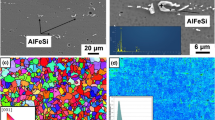Abstract
This work studied the effect of kissing bond defects on the fatigue strength of friction stir welded (FSW) specimens and assessed fatigue life prediction approaches for the fatigue strength evaluation of friction stir welded specimens. For specimens with inherent kissing bond defects prepared by friction stir welding process made of AA5083 aluminum alloy thin sheets, constant amplitude fatigue tests under different loading levels were carried out on MTS test frame. Profiles of kissing bond defects at weld toes as well as the fatigue fracture morphologies were observed with scanning electron microscopy. According to the experimental observations, finite element models based on both the virtual notch radius theory and the crack propagation conception were built, respectively, to calculate the stress and strain in the weld zone. Correspondingly, fatigue lives were predicted by these two methods and compared with experimental results.
Similar content being viewed by others
Abbreviations
- R:
-
Loading ratio, R = Fmin/Fmax
- Fmin :
-
Minimum load
- Fmax :
-
Maximum load
- Δσ:
-
Stress amplitude
- Ne :
-
Experimental fatigue life
- Hv:
-
Vickers hardness
- d:
-
Kissing bond depth
- rref :
-
Reference radius
- Fm :
-
Mean load
- Fa:
-
Load amplitude
- E:
-
Elastic modulus
- v:
-
Poisson ratio
- FAT:
-
Characteristic fatigue strength at N 2×106
- C:
-
Constant in equation of S-N curve
- m:
-
Exponent in equation of S-N curve
- S:
-
Stress
- KI :
-
Mode I crack stress intensity factor
- F:
-
Crack shape function
- a:
-
Crack length
- b:
-
Plate width
- C0 :
-
Constant of the power law
- ΔK :
-
Range of cyclic stress intensity factor
- ΔKth :
-
Threshold value of stress intensity
- Np :
-
Predicted fatigue life
References
S. J. Maddox, Review of fatigue assessment procedures for welded aluminum structures, International J. of Fatigue, 25(12) (2003) 1359–1378.
A. Haboudou, P. Peyre, A. B. Vannes and G. Peix, Reduction of porosity content generated during Nd:YAG laser welding of A356 and AA5083 aluminium alloys, Materials Science and Engineering A, 363(1–2) (2003) 40–52.
R. Ashok kumar and M. R. Thansekhar, Mechanical and wear properties of friction stir welded dissimilar AA6101-T6 and AA1350 alloys: Effect of offset distance and number of passes, Journal of Mechanical Science and Technology, 32(7) (2018) 3299–3307.
Z. Zhang, B. L. Xiao and Z. Y. Ma, Effect of welding parameters on microstructure and mechanical properties of friction stir welded 2219Al-T6 joints, J. of Materials Science, 47(9) (2012) 4075–4086.
D. G. Moghadam, K. Farhangdoost and R. M. Nejad, Microstructure and residual stress distributions under the influence of welding speed in friction stir welded 2024 aluminum alloy, Metallurgical and Materials Transactions B, 47(3) (2016) 2048–2062.
K. Şefika and S. Ozan, Effects of overlapping formed via pinoffsetting on friction stir weldability of AA7075-T651 aluminum alloy, Journal of Mechanical Science and Technology, 33(2) (2019) 819–828.
S. Di, X. Yang, G. Luan and B. Jian, Comparative study on fatigue properties between AA2024-T4 friction stir welds and base materials, Materials Science and Engineering A, 435 (2006) 389–395.
T. L. Dickerson and J. Przydatek, Fatigue of friction stir welds in aluminum alloys that contain root flaws, International J. of Fatigue, 25(12) (2003) 1399–1409.
C. Zhou, X. Yang and G. Luan, Effect of root flaws on the fatigue property of friction stir welds in 2024-T3 aluminum alloys, Materials Science and Engineering A, 418(1–2) (2006) 155–160.
A. Hobbacher, Recommendations for Fatigue Design of Welded Joints and Components, IIW Collection, Springer International Publishing (2016).
S. Eslami, B. V. Farahani, P. J. Tavares and P. M. G. P. Moreira, Fatigue behaviour evaluation of dissimilar polymer joints: Friction stir welded, single and double-rivets, International J. of Fatigue, 113 (2018) 351–358.
H. Polezhayeva, A. I. Toumpis, A. M. Galloway, L. Molter, B. Ahmad and M. E. Fitzpatrick, Fatigue performance of friction stir welded marine grade steel, International J. of Fatigue, 81 (2015) 162–170.
W. Fricke, IIW Recommendations for the Fatigue Assessment of Welded Structures By Notch Stress Analysis, IIW-2006-09 (2012).
H. J. K. Lemmen, R. C. Alderliesten and R. Benedictus, Macro and microscopic observations of fatigue crack growth in friction stir welded aluminum joints, Engineering Fracture Mechanics, 78(6) (2011) 930–943.
G. Pouget and A. P. Reynolds, Residual stress and microstructure effects on fatigue crack growth in AA2050 friction stir welds, International J. of Fatigue, 30(3) (2008) 463–472.
Acknowledgments
This work is partially funded by the National Natural Science Foundation of China (Grant No. 51065012), China.
Author information
Authors and Affiliations
Corresponding author
Additional information
Recommended by Editor Chongdu Cho
Ruijie Wang is an Associate Professor in Faculty of Mechanical and Electrical Engineering at Kunming University of Science and Technology. He received his B.S. in Machinery Manufacturing Process and Technology from Kunming University of Science and Technology in 1995. He received his Ph.D. from Beijing University of Technology in 2008. Dr. Wang’s current research interests include fatigue strength welded structures, fracture mechanics, finite element analysis.
Peng Mi is a graduate student in Mechanical and Electrical Engineering at Kunming University of Science and Technology. He received his B.S. in Mechanical Design and Manufacture & Automation from Yulin University in 2017. His current research interests include fatigue strength welded structures, finite element analysis.
Rights and permissions
About this article
Cite this article
Wang, R., Mi, P. Study on fatigue strength of FSW joints of 5083 aluminum alloy with kissing bond defect. J Mech Sci Technol 34, 2761–2766 (2020). https://doi.org/10.1007/s12206-020-0608-3
Received:
Revised:
Accepted:
Published:
Issue Date:
DOI: https://doi.org/10.1007/s12206-020-0608-3




